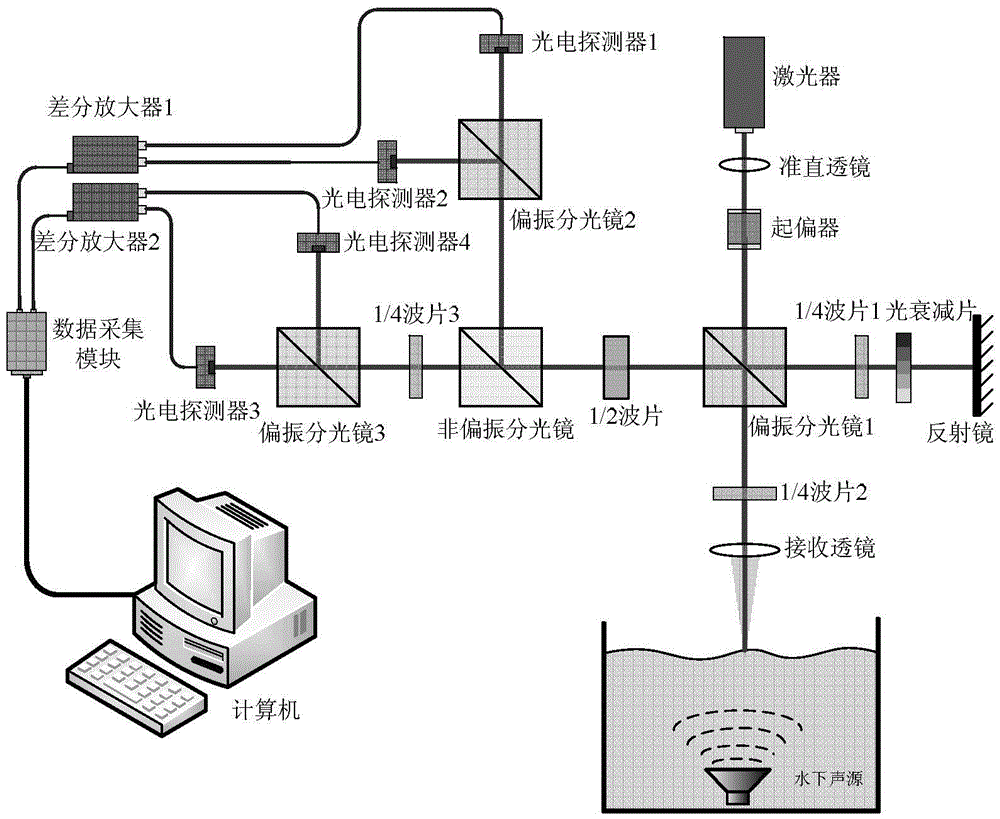Underwater acoustic signal real-time extraction method based on laser orthogonal polarization interference technology
An underwater acoustic signal and orthogonal polarization technology, which is applied in the direction of measuring ultrasonic/sonic/infrasonic waves, measuring devices, instruments, etc., can solve the problem that real-time extraction of underwater acoustic signals cannot be realized, and it is difficult to meet the needs of large-scale underwater activities. problems with detection, lack of mobility, etc.
- Summary
- Abstract
- Description
- Claims
- Application Information
AI Technical Summary
Problems solved by technology
Method used
Image
Examples
specific Embodiment approach 1
[0041] Specific embodiment one: a kind of real-time extraction method of underwater acoustic signal based on laser orthogonal polarization interference technology of the present embodiment, it is realized according to the following steps:
[0042] 2. Build a passive homodyne interferometer system:
[0043] The passive homodyne interferometer system includes laser orthogonal polarization interference optical path, detection signal processing circuit and computer terminal;
[0044] Wherein, the laser orthogonal polarization interference optical path includes a laser, a collimating lens, a polarizer (such as a Glan Taylor prism), a polarizing beam splitting prism 1, a polarizing beam splitting prism 2, a polarizing beam splitting prism 3, a non-polarizing beam splitting mirror, and a receiving lens , 1 / 4 wave plate 1, 1 / 4 wave plate 2, 1 / 4 wave plate 3, 1 / 2 wave plate, light attenuation plate and reflector;
[0045] The detection signal processing circuit includes a photodetecto...
specific Embodiment approach 2
[0066] Embodiment 2: This embodiment differs from Embodiment 1 in that: the vibration direction of the S light in step 3 is along the Y axis, and the vibration direction of the P light is along the X axis.
[0067] Other steps and parameters are the same as those in Embodiment 1.
specific Embodiment approach 3
[0068] Specific implementation mode three: the difference between this implementation mode and specific implementation mode one or two is that step nine adopts the demodulation method to obtain the phase of the detection signal as follows:
[0069] (1) Use such as figure 2 The shown processing flow (that is, the DCM demodulation flow): two orthogonal signals f I with f Q have the same phase, the phase of the two signals is denoted as Then the two quadrature signals f I with f Q After differentiation and cross multiplication, the two paths can be expressed as: and
[0070] (2) The signal obtained by the two-way differential cross multiplication is then differentially amplified and integrated to obtain the phase of the detection signal Proportional to a signal, the proportionality factor is K 2 , or two quadrature detection signals f I with f Q The aforementioned proportional coefficient K can be obtained by adding squares 2 ;
[0071] (3) Divide the signal obta...
PUM
 Login to View More
Login to View More Abstract
Description
Claims
Application Information
 Login to View More
Login to View More - R&D
- Intellectual Property
- Life Sciences
- Materials
- Tech Scout
- Unparalleled Data Quality
- Higher Quality Content
- 60% Fewer Hallucinations
Browse by: Latest US Patents, China's latest patents, Technical Efficacy Thesaurus, Application Domain, Technology Topic, Popular Technical Reports.
© 2025 PatSnap. All rights reserved.Legal|Privacy policy|Modern Slavery Act Transparency Statement|Sitemap|About US| Contact US: help@patsnap.com



